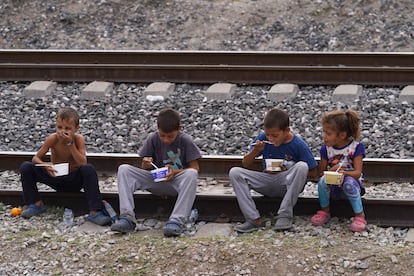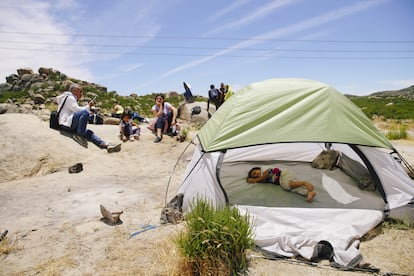The immigration crisis fuels child labor in the United States
Latino migrant minors, especially if traveling alone, are at greater risk of exploitation in factories across the country

The job was to operate a machine that transforms sheet metal into auto components. The location was the Smart plant in Luverne, Alabama, which provides components for the Hyundai automaker. The person in charge of this task worked between 50 and 60 hours per week, for a minimum of six months. All this information is contained in a recent lawsuit filed by the U.S. Department of Labor, and the person doing the work was a 13-year-old girl. Sometimes you don’t have to travel to remote places to put a face to child labor.
The lawsuit, a rare occurrence in these cases, opens a legal proceeding with Hyundai, the component manufacturer — Smart, which since 2023 has been called ITAC Alabama — and a contracting company, Best Practice Services. Hyundai says that child labor is against the company’s values and that it is unfair to include them in a lawsuit because of what a supplier does.
The reality is that this girl’s situation is not an isolated occurrence in the United States. The Department of Labor has verified an increase in cases of child labor in violation of federal law: the Fair Labor Standard Act of 1938, which includes child labor legislation. Cases involving 5,792 children nationwide were investigated last year, and hundreds of them were employed in hazardous occupations. The department has not made public the names or nationalities of the minors but Reuters and The New York Times investigations have revealed that in numerous cases those who end up working in factories are Latino migrant children, many of them arriving in the U.S. unaccompanied by adults.

“There are aspects of the status of unaccompanied immigrant youth that make them more vulnerable to these types of situations,” explains Nina Mast, an analyst with the Economic Policy Institute’s (EPI) Research and Analysis Network. “Because of their situation they may be forced to work in jobs that may have high wages but at the same time jeopardizing their health, safety, and education, and they don’t have a parent or guardian to ensure that what they are doing is appropriate.” Daniel Costa, EPI’s director of Immigration Law and Policy Research, explains that migrant minors face “all kinds of pressures” because of their precarious status, which leads them to accept difficult conditions. In addition, they have no incentive to report their illegal status because of the immigration situation they are in.
Mast notes that there is a bipartisan consensus that fines for labor law violations are low and do not provide a deterrent. They are simply one more barely noticeable cost of doing business for many large companies. The laws “are important but relatively weak by labor standards, as well as outdated,” she notes.
Raising the financial penalties, however, is only one of the methods that can be updated or incorporated into the fight against illegal child labor. Another alternative highlighted by experts is to criminally prosecute these practices, as long as it is against the companies in question and “not mid-level managers who may also be vulnerable to abuse within the organization,” says Mast.
Tara Watson, an economist focusing on policy and social networking as well as immigration at the Brookings think tank, explains that fines are not enough and that there are grounds to consider criminality in cases where an 11-year-old child is hired to perform a dangerous activity. One of her proposals is to improve enforcement by the Department of Labor, which is complicated when it is underfunded and lacks sufficient personnel.
Costa explains that there are fewer than 800 researchers — a historic low since the 1970s — responsible for policing a labor market of 160 million people. “You could triple the number of staff in the department and still be below what is needed,” he notes. The funding level has not been updated from 2006 to 2022. Watson notes that $25 billion a year is dedicated to ICE (immigration enforcement), but barely $2 billion to protect labor standards and labor agencies. Updating legislation to 21st century realities is another pending issue, as well as reworking the list of hazardous work for minors. There are currently 17 such activities included on the list but it has not been updated for a long time, no matter how hard it has been attempted.
Mast believes that to encourage the reporting of these illegalities, the criminal liability of parents must be eliminated: “At the state level there are places where parents who are aware of the illegality of a child’s employment are criminalized and that creates a negative effect.” These specialists believe that families can be given monetary relief for reporting violations, something that currently is not the case as the money from fines goes into a general fund, although in recent months the Department of Labor has forced companies to turn over the equivalent of the benefit gained by child labor to the minors. This came about via one of the largest agreements ever reached in this area. The government and a Los Angeles chicken processor and distributor agreed to, among other things, subtract $1 million from the profits accrued from the oppressive labor of children under the age of 14, who used sharp knives to bone the meat.
Increasing the minimum wage and eliminating the sub-minimum depending on age, as well as supporting workers so they can protest working conditions and allowing anonymous reports of illegal circumstances via an app, are some of the avenues being pursued to bring about change.
Deferred action
There was a key development in early 2023, when the Department of Homeland Security announced the deferred action process to protect migrant workers who were victims or witnesses to labor law violations from deportation. This measure already existed, but was formalized by the Biden administration. Even so, many of the measures that can be put in place now require congressional action and that makes it difficult to move forward. According to Costa, it is not only open to question whether Republican votes can be counted on in this matter, but also those of some Democrats.
Although there are certain modifications at the state level that strengthen some of the tools to curb child labor — such as raising fines or eliminating criminal liability for parents — Mast says that there are a number of attempts in some states “to legalize the violations that are occurring in some industries.”
Of particular concern is interest in eliminating work permits by an agency or department of education, or expanding risky jobs. In Florida, a law was initially passed that would allow minors aged 16 and 17 to work on ladders and roofs, which is prohibited at the federal level. Mast sees this as just one example among many: “It ultimately didn’t get implemented, but these are the kinds of changes they want to make.”
Sign up for our weekly newsletter to get more English-language news coverage from EL PAÍS USA Edition
Tu suscripción se está usando en otro dispositivo
¿Quieres añadir otro usuario a tu suscripción?
Si continúas leyendo en este dispositivo, no se podrá leer en el otro.
FlechaTu suscripción se está usando en otro dispositivo y solo puedes acceder a EL PAÍS desde un dispositivo a la vez.
Si quieres compartir tu cuenta, cambia tu suscripción a la modalidad Premium, así podrás añadir otro usuario. Cada uno accederá con su propia cuenta de email, lo que os permitirá personalizar vuestra experiencia en EL PAÍS.
¿Tienes una suscripción de empresa? Accede aquí para contratar más cuentas.
En el caso de no saber quién está usando tu cuenta, te recomendamos cambiar tu contraseña aquí.
Si decides continuar compartiendo tu cuenta, este mensaje se mostrará en tu dispositivo y en el de la otra persona que está usando tu cuenta de forma indefinida, afectando a tu experiencia de lectura. Puedes consultar aquí los términos y condiciones de la suscripción digital.
More information
Archived In
Últimas noticias
Delta Force, the elite US military unit that captured Maduro
Maduro to be tried in the US for narcoterrorism and corruption
Maps of the US attack on Venezuela: Targets, airspace and deployed fleet
Venezuelans in exile: ‘This could be the end of a very dark chapter for Venezuela, but also the beginning of a time of uncertainty’
Most viewed
- Alain Aspect, Nobel laureate in physics: ‘Einstein was so smart that he would have had to recognize quantum entanglement’
- David King, chemist: ‘There are scientists studying how to cool the planet; nobody should stop these experiments from happening’
- Mexico completes its trade shift with the entry into force of tariffs on China and countries without trade agreements
- Reinhard Genzel, Nobel laureate in physics: ‘One-minute videos will never give you the truth’
- Oona Chaplin: ‘I told James Cameron that I was living in a treehouse and starting a permaculture project with a friend’











































